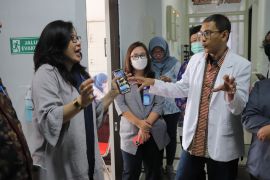"The policy from the Health Ministry states that the most important aspect in the use of tear gas is cross-sectoral cooperation to check the importance of using it to control the riot," the ministry's Director of Prevention and Control of Non-Communicable Diseases Eva Susanti stated at a press conference on World Sight Day that was followed from Jakarta on Tuesday.
Susanti remarked that strong regulations were deemed necessary in the use of high doses of tear gas for controlling riots involving masses.
Susanti explained that tear gas contains chemicals -- chloroacetophenone (CN), chlorobenzylidenemalononitrile (CS), chloropicrin (PS), bromobenzylcyanide (CA), and dibenzoxazepine (CR) -- that can have health implications.
"Tear gas is a little bit useful for riots, but it is actually not lethal. Serious injuries may occur if exposed in large doses," she stated.
The instant effect of tear gas on sufferers can interfere with the visual process, which can lead to physical impacts, bone injuries, blood vessel injuries, and others, she stated.
Related news: Police announce scholarship for child orphaned in Kanjuruhan tragedy
"Better coordination in future is necessary for the use of tear gas," Susanti remarked.
At the same event, General Chairperson of the Central Board of the Indonesian Ophthalmologist Association (Perdami) M. Sidik stated that the chemical content of tear gas can cause irritation that can heal on its own if handled properly.
"If we wash it, the irritation will subside and usually does not cause permanent consequences. However, the irritation will hurt and trigger tears to continually flow from the eyes, thereby making it difficult for people to see," Sidik stated.
Other effects that should be anticipated from tear gas are shortness of breath, lung disorders, sore throat, and others.
Swelling of the cornea of the eye due to exposure to chemical tear gas is also very uncomfortable for sufferers, Sidik added.
Related news: Under one-month task completion target for TGIPF: President
Translator: Andi Firdaus, Resinta S
Editor: Rahmad Nasution
Copyright © ANTARA 2022












